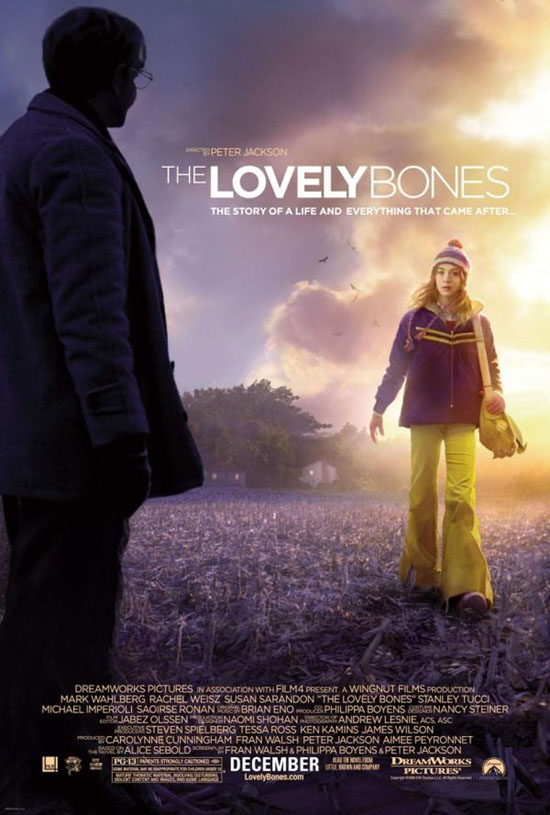
A whole lot of not so lovely CGI
Peter Jackson knows how to pick his source material. Maturing from fantastically gory zombie films to the most epic trilogy of my generation he is never one to back away from a challenge. His latest venture, an adaptation of Alice Sebold’s phenomenally popular novel The Lovely Bones was hardly going to make life easier for himself. He chose to follow up his overlong but effective King Kong, with a story involving the rape and murder of a 14 year old girl, the afterlife, the emotional breakdown of a family and a homicide investigation that stretches on for half a decade. What he has created is an ambitious, yet messy film.
For those of you who have not seen the trailer, the films catalyst is the brutal murder of teenager Susie Salmon at the hands of her neighbour George Harvey. After her death, she resides in the ‘in-between’ a purgatory like domain in which she watches how her death impacts her family.
The 12A certificate surprised a lot of people considering what the film deals with; a teen friendly film involving child murder? Interestingly the most effective moments are the darker ones, and despite the low age certificate there are some genuinely frightening and disturbing moments throughout. Without resorting to graphic acts of violence, Jackson creates a foreboding atmosphere leading up to the inevitable murder of our protagonist. As we watch Susie go about her life, building ships in bottles with her father, developing her photography hobby, and shying away from her crush on boy at her school, her narration from the after-life is a constant reminder that this will soon change.
Initially the characters are fleshed out and generally well acted, and up until her departure into the ‘in-between’ I was fully absorbed. The crux of the film, Susie’s murder is an unbearably tense sequence when she is fooled into a trap set up by neighbour/serial killer George. Stanley Tucci has received an Oscar nomination for his portrayal of the character and it was well deserved. George Harvey creates the same menace that has been rarely seen since Anthony Hopkins steeped into the shoes of Hannibal ‘the cannibal’ Lecture. His subtle change from friendly neighbour to something far more sinister is an awesome and brave display of acting. His terrifying staring and heavy breathing create more unease that I have felt in the cinema in some time. Due to its relevance to recent related news stories, the death of Susie Salmon is nothing less than devastating cinema.
It is after her untimely demise that the film takes a u-turn and loses its way. The after-life is never an easy thing to depict, every individual on this earth has their own vision of it, and Jackson’s does not work. The after-life is seldom successfully created on screen; the last ambitious and failed attempt was in ‘What Dreams May Come’ starring Robin Williams. Like that film, this depiction is far to CGI heavy. I am never a supporter of reviewing a film through comparison to the novel it is based on; they are too different mediums and therefore warrant different approaches. However, the beauty of Sebold’s novel was her imaginative vision of the after-life. Susie’s paradise is personalised to her, it is shaped by her personality. The vision of ‘the in-between’ here is a cross between an acid hallucination and a Bjork song. Giant mountainous vistas give way to sparkling rivers. Huge beach balls roll across waves. Vast corn fields morph into swamps. It’s all very stylish, but has no substance. The great human unknown, the after-life, is reduced to a CGI showcase. At one point Susie utters ‘it’s beautiful’ as she gazes across her computer generated environment. I had to disagree.
The most cringe worthy moments involves Susie running through ever changing locations while an awful song wails on. It is like an expensive, soulless music video.
Jackson also seems unsure how to blend the after-life with reality. Susie looks into various portals that allow her to see the events on earth. Various parallels are drawn as her ‘in-between’ is shaped by the events on earth. It’s an interesting concept, not only the living letting go of the dead but the dead letting go of the living, but it is never explored deeply enough. I found myself getting impatient with the scenes involving Susie and itching to get back to earth. Due to the reliance on CGI and dreamy, unfocused direction, the connection between earth and the afterlife negatively affect the story. Cross-cutting between the two locations becomes confusing, tacky and tedious.
Despite these sequences, the film is at its best grounded in reality, and when it works, it is an excellent psychological thriller. Jackson uses murderer George Harvey sparingly making him a mysterious and frightening presence. Moments of real terror are effectively staged, including a nail biting homage to Hitchcock’s Rear Window. Whilst not skimping on the horror aspects of the story, the film does tone town the emotional turmoil of the family. The events understandably tear relationships apart but these moments lack any real emotional pull. One of the Novel’s most interesting characters, Susie’s alcoholic grandmother is, disturbingly enough, reduced to comic relief. His father’s fixation with solving the case is effectively shown, but his wife, played excellently by Rachel Weiss is hardly present. She moves away from home to order to escape domestic traumas but this is skimmed over very quickly.
All is not lost though. One family member who is used well is Susie’s little Sister Lindsey. Susie watches her grow up and enjoy experiences that she will never have, such as a first kiss, and this leads to some heartbreaking moments as she watches on, realising life experience has been taken from her. This connection between life and the after-life is affecting, but on the whole, it is never clear if/how Susie is connecting with her loved ones on earth; the two locations are linked tenuously.
Verdict
The Lovely Bones is a film of two half’s. An effective, emotional and terrifying thriller is tainted by an effects heavy, soulless exploration of the afterlife. Ultimately it is Peter Jackson’s unrelenting ambition that is the films downfall. In trying to cram so much into the films running time, he ends up overusing visual effects, and under using attempts at emotional involvement. If there is a movie after life, half of this film is going to heaven, and half can burn in hell.
6.5/10
A note on ratings – I am generally adverse to reducing move reviews to quantifiable ratings such as the star system seen in Empire and the numerical system used on IMDB.com....However, as I’ll soon be taking this blog to local newspapers I will do doing it from now on as it offers a quick guide to my verdict on the film. However, the review is where the information is. How can a 8/10 horror film be compared to an 8/10 political thriller or art house film. Number ratings are flawed, and each film needs to be taken on its own merit. An effectively exploitation picture and an Oscar contender cannot be compared in terms of traditional film quality, but still may score 9/10 each if they are strong in their own fields. Anyway, I’ll give this rating thing a go.


No comments:
Post a Comment